PEUGEOT 5008 2013 Owners Manual
Manufacturer: PEUGEOT, Model Year: 2013, Model line: 5008, Model: PEUGEOT 5008 2013Pages: 364, PDF Size: 16.24 MB
Page 211 of 364

PRACTICAL INFORMATION
209
Starting using another battery
When your vehicle's battery is dis-
charged, the engine can be started using
a slave battery (external or on another
vehicle) and jump lead cables.
First check that the slave battery has a
nominal voltage of 12 V and a capacity
at least equal to that of the discharged
battery.
Do not try to start the engine by connecting
a battery charger.
Do not disconnect the (+) terminal when
the engine is running.
�)
Connect the red cable to the posi-
tive terminal (+) of the fl at battery A
,
then to the positive terminal (+) of
the slave battery B
.
�)
Connect one end of the green or
black cable to the negative terminal
(-) of the slave battery B
(or earth
point on the other vehicle).
�)
Connect the other end of the green
or black cable to the earth point C
on the broken down vehicle (or on
the engine mounting).
�)
Start the engine of the vehicle with
the good battery and leave it run-
ning for a few minutes.
�)
Operate the starter on the broken
down vehicle and let the engine run
If the engine does not start straight
away, switch off the ignition and wait
a few moments before trying again.
�)
Wait until the engine returns to idle
then disconnect the jump lead ca-
bles in the reverse order.
Charging the battery using a
battery charger
�)
Disconnect the battery from the ve-
hicle.
�)
Follow the instructions for use pro-
vided by the manufacturer of the
charger.
�)
Connect the battery starting with the
negative terminal (-).
�)
Check that the terminals and connec-
tors are clean. If they are covered with
sulphate (whitish or greenish deposit),
remove them and clean them.
The batteries contain harmful
substances such as sulphuric
acid and lead. They must be dis-
posed of in accordance with regulations
and must not, in any circumstances, be
discarded with household waste.
Take used remote control batteries
and vehicle batteries to a special col-
lection point.
It is advisable to disconnect the
battery if the vehicle is to be left
unused for more than one month.
Page 212 of 364
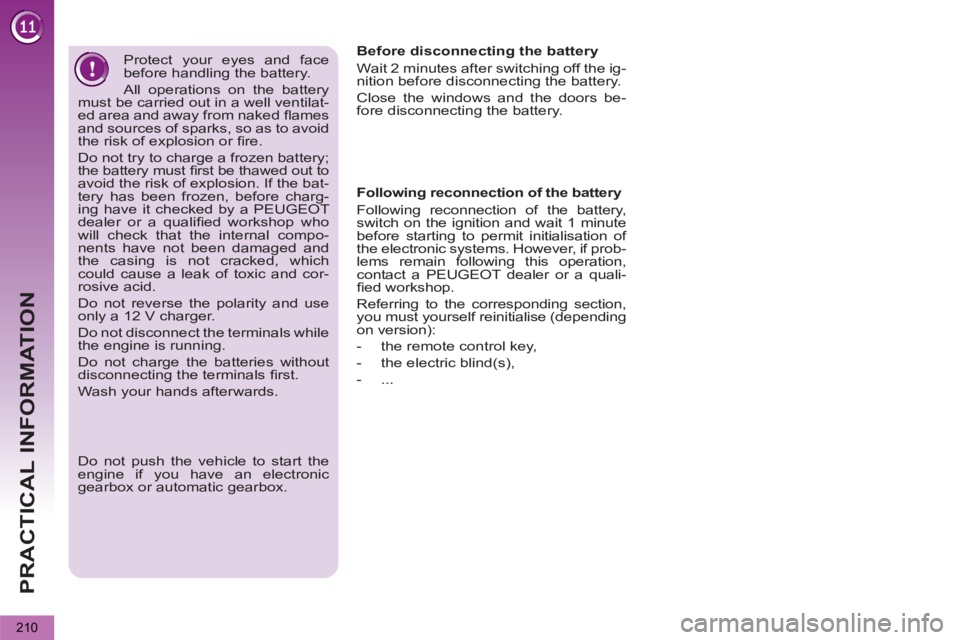
PRACTICAL INFORMATION
210
Protect your eyes and face
before handling the battery.
All operations on the battery
must be carried out in a well ventilat-
ed area and away from naked fl ames
and sources of sparks, so as to avoid
the risk of explosion or fi re.
Do not try to charge a frozen battery;
the battery must fi rst be thawed out to avoid the risk of explosion. If the bat-
tery has been frozen, before charg-
ing have it checked by a PEUGEOT
dealer or a qualifi ed workshop who
will check that the internal compo-
nents have not been damaged and
the casing is not cracked, which
could cause a leak of toxic and cor-
rosive acid.
Do not reverse the polarity and use
only a 12 V charger.
Do not disconnect the terminals while
the engine is running.
Do not charge the batteries without
disconnecting the terminals fi rst.
Wash your hands afterwards.
Do not push the vehicle to start the
engine if you have an electronic
gearbox or automatic gearbox.
Before disconnecting the battery
Wait 2 minutes after switching off the ig-
nition before disconnecting the battery.
Close the windows and the doors be-
fore disconnecting the battery.
Following reconnection of the battery
Following reconnection of the battery,
switch on the ignition and wait 1 minute
before starting to permit initialisation of
the electronic systems. However, if prob-
lems remain following this operation,
contact a PEUGEOT dealer or a quali-
fi ed workshop.
Referring to the corresponding section,
you must yourself reinitialise (depending
on version):
- the remote control key,
- the electric blind(s),
- ...
Page 213 of 364
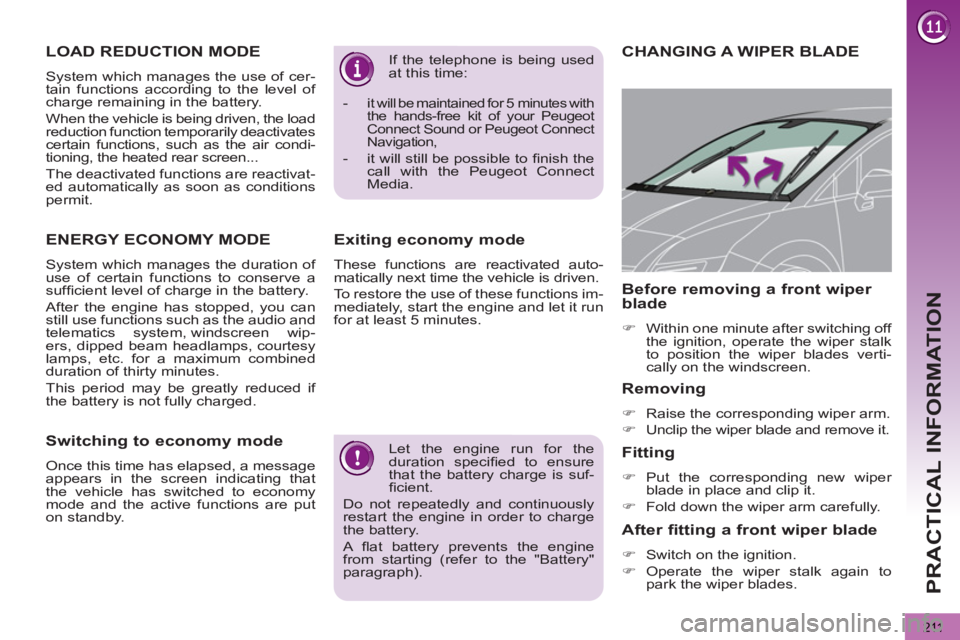
PRACTICAL INFORMATION
211
Let the engine run for the
duration specifi ed to ensure
that the battery charge is suf-
fi cient.
Do not repeatedly and continuously
restart the engine in order to charge
the battery.
A fl at battery prevents the engine
from starting (refer to the "Battery"
paragraph). If the telephone is being used
at this time:
- i
t will be maintained for 5 minutes with
the hands-free kit of your Peugeot
Connect Sound or Peugeot Connect
Navigation,
- it will still be possible to fi nish the
call with the Peugeot Connect
Media.
Exiting economy mode
These functions are reactivated auto-
matically next time the vehicle is driven.
To restore the use of these functions im-
mediately, start the engine and let it run
for at least 5 minutes.
CHANGING A WIPER BLADE
Removing
�)
Raise the corresponding wiper arm.
�)
Unclip the wiper blade and remove it.
Fitting
�)
Put the corresponding new wiper
blade in place and clip it.
�)
Fold down the wiper arm carefully.
Before removing a front wiper
blade
�)
Within one minute after switching off
the ignition, operate the wiper stalk
to position the wiper blades verti-
cally on the windscreen.
After fitting a front wiper blade
�)
Switch on the ignition.
�)
Operate the wiper stalk again to
park the wiper blades.
LOAD REDUCTION MODE
System which manages the use of cer-
tain functions according to the level of
charge remaining in the battery.
When the vehicle is being driven, the load
reduction function temporarily deactivates
certain functions, such as the air condi-
tioning, the heated rear screen...
The deactivated functions are reactivat-
ed automatically as soon as conditions
permit.
ENERGY ECONOMY MODE
System which manages the duration of
use of certain functions to conserve a
suffi cient level of charge in the battery.
After the engine has stopped, you can
still use functions such as the audio and
telematics system, windscreen wip-
ers, dipped beam headlamps, courtesy
lamps, etc. for a maximum combined
duration of thirty minutes.
This period may be greatly reduced if
the battery is not fully charged.
Switching to economy mode
Once this time has elapsed, a message
appears in the screen indicating that
the vehicle has switched to economy
mode and the active functions are put
on standby.
Page 214 of 364

PRACTICAL INFORMATION
212
TOWING THE VEHICLE
Procedure for having your vehicle towed
or for towing another vehicle using a re-
movable towing eye.
Access to the tools
Towing from the front
�)
On the front bumper, unclip the cover
by pressing at the bottom.
�)
Screw the towing eye in fully.
�)
Install the towing bar.
�)
Switch on the hazard warning lamps
on the towed vehicle.
�)
On the rear bumper, unclip the cover
by pressing at the bottom.
�)
Screw the towing eye in fully.
�)
Install the towing bar.
�)
Switch on the hazard warning lamps
on the towed vehicle.
Towing from the rear
The towing eye is installed under the
left-hand concertina board, in the boot
interior trim.
To gain access to it:
�)
open the boot,
�)
raise the concertina board,
�)
remove the towing eye from the
holder.
�)
Place the gear lever in neu-
tral (position N
on the elec-
tronic gear control gearbox
or automatic gearbox).
Failure to observe this special condi-
tion could result in damage to certain
braking components and the absence
of braking assistance the next time
the engine is started.
Page 215 of 364

PRACTICAL INFORMATION
213
TOWING A TRAILER
Your vehicle is primarily designed for
transporting people and luggage, but it
may also be used for towing a trailer.
Driving advice
Side wind
�)
Take into account the increased
sensitivity to side wind.
Cooling
Towing a trailer on a slope increases
the temperature of the coolant.
As the fan is electrically controlled, its
cooling capacity is not dependent on
the engine speed.
�)
To lower the engine speed, reduce
your speed.
Towbar suitable for the attachment of a
trailer or installation of a bicycle carrier,
with additional lighting and signalling.
Distribution of loads
�)
Distribute the load in the trailer so
that the heaviest items are as close
as possible to the axle and the nose
weight approaches the maximum
permitted without exceeding it.
Air density decreases with altitude, thus
reducing engine performance. Above
1 000 metres, the maximum towed load
must be reduced by 10 % for every
1 000 metres of altitude.
Driving with a trailer places greater de-
mands on the towing vehicle and the
driver must take particular care.
We recommend the use of
genuine PEUGEOT towbars
and their harnesses that have
been tested and approved from the
design stage of your vehicle, and that
the fi tting of the towbar is entrusted
to a PEUGEOT dealer or a qualifi ed
workshop.
If the towbar is not fi tted by a
PEUGEOT dealer, it is imperative
that it is fi tted in accordance with the
vehicle manufacturer's instructions.
General
recommendations
Observe the legislation in force in
your country.
Ensure that the weight of the tow-
ing vehicle is higher than that of the
towed vehicle.
The person at the wheel of the towed
vehicle must have a valid driving li-
cence.
When towing a vehicle with all four
wheels on the ground, always use an
approved towing bar; rope and straps
are prohibited.
When towing a vehicle with the en-
gine off, there is no longer any power
assistance for braking or steering.
In the following cases, you must al-
ways call on a professional recovery
service:
- vehicle broken down on a motor-
way or fast road,
- 4 wheel drive vehicle,
- when it is not possible to put the
gearbox into neutral, unlock the
steering, or release the parking
brake,
- towing with only two wheels on
the ground,
- where there is no approved towing
bar available...
Refer to the "Technical data" section for
details of the weights and towed loads
which apply to your vehicle.
Page 216 of 364

PRACTICAL INFORMATION
214
The maximum towed load on a long in-
cline depends on the gradient and the
ambient temperature.
In all cases, keep a check on the cool-
ant temperature.
Braking
Towing a trailer increases the braking
distance.
To avoid overheating of the brakes on a
long mountain type of descent, the use
of engine braking is recommended.
Tyres
�)
Check the tyre pressures of the tow-
ing vehicle and of the trailer, observ-
ing the recommended pressures.
Lighting
�)
Check the electrical lighting and sig-
nalling on the trailer.
The rear parking sensors will
be deactivated automatically if
a genuine PEUGEOT towbar
is used.
�)
If the warning lamp and the
STOP
warning lamp come
on, stop the vehicle and
switch off the engine as
soon as possible.
FITTING ROOF BARS
Maximum authorised weight
on the roof rack, for a loading
height not exceeding 40 cm
(with the exception of bicycle
carriers): 65
kg.
If the height exceeds 40 cm, adapt
the speed of the vehicle to the pro-
fi le of the road to avoid damaging the
roof bars and the fi xings on the roof.
Be sure to refer to national legislation
in order to comply with the regula-
tions for transporting objects that are
longer than the vehicle.
When fi tting transverse roof bars, use
the four quick-fi t fi xings provided for this
purpose:
�)
lift the concealing fl aps,
�)
open the fi xing covers on each bar
using the key,
�)
put each fi xing in place and lock
them on the roof one by one,
�)
ensure that roof bars are correctly
fi tted (by shaking them),
�)
close the fi xing covers on each bar
using the key.
If your vehicle is fi tted with
roof fi nishers, do not use them
for carrying loads.
Page 217 of 364
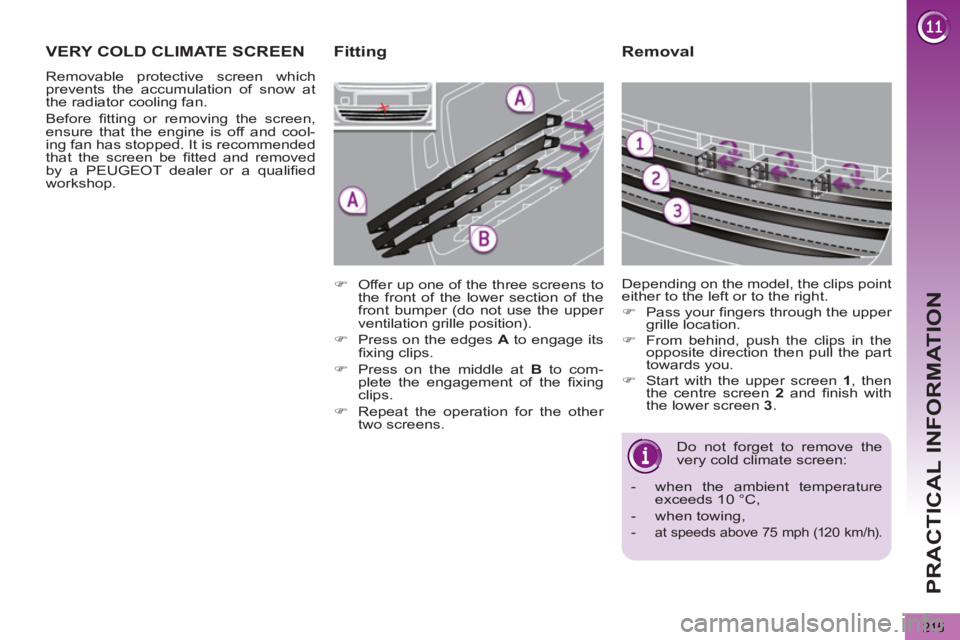
PRACTICAL INFORMATION
215
Removal
Do not forget to remove the
very cold climate screen:
- when the ambient temperature
exceeds 10 °C,
- when towing,
-
at speeds above 75 mph (120 km/h).
Depending on the model, the clips point
either to the left or to the right.
�)
Pass your fi ngers through the upper
grille location.
�)
From behind, push the clips in the
opposite direction then pull the part
towards you.
�)
Start with the upper screen 1
, then
the centre screen 2
and fi nish with
the lower screen 3
.
VERY COLD CLIMATE SCREEN
Removable protective screen which
prevents the accumulation of snow at
the radiator cooling fan.
Before fi tting or removing the screen,
ensure that the engine is off and cool-
ing fan has stopped. It is recommended
that the screen be fi tted and removed
by a PEUGEOT dealer or a qualifi ed
workshop.
�)
Offer up one of the three screens to
the front of the lower section of the
front bumper (do not use the upper
ventilation grille position).
�)
Press on the edges A
to engage its
fi xing clips.
�)
Press on the middle at B
to com-
plete the engagement of the fi xing
clips.
�)
Repeat the operation for the other
two screens.
Fitting
Page 218 of 364

PRACTICAL INFORMATION
216
"Multimedia":
audio systems, amplifi ers, satellite navigation systems, Bluetooth hands-free system, CD
changer, speakers, DVD player, USB Box,
front and rear parking sensors, additional
Bluetooth wireless headphones, Bluetooth
audio headphones mains charger.
Installation of radio
communication
transmitters
Before installing any after-market ra-
dio communication transmitter, you
can contact a PEUGEOT dealer for
the specifi cation of transmitters which
can be fi tted (frequency, maximum
power, aerial position, specifi c instal-
lation requirements), in line with the
Vehicle Electromagnetic Compatibility
Directive (2004/104/EC).
"Protection":
mats * , boot tray, luggage net, coat
hanger fi xed on head restraint, stainless
steel or carbon fi bre style door sills.
*
To avoid any risk of jamming of the
pedals:
- ensure that the mat is positioned
and secured correctly,
- never fi t one mat on top of another.
ACCESSORIES
A wide range of accessories and genu-
ine parts is available from the PEUGEOT
dealer network.
These accessories and parts have been
tested and approved for reliability and
safety.
They are all adapted to your vehicle and
benefi t from PEUGEOT's recommenda-
tion and warranty.
"Safety and security":
anti-theft alarm, window etching, wheel
security bolts, fi rst aid kit, breathalyzer,
warning triangle, high visibility vest, sto-
len vehicle tracking system, dog guard,
snow chains.
"Style":
seat covers compatible with lateral air-
bags, leather gear lever knob, foglamps,
door defl ectors, spoiler, styling strips,
alloy wheels, trims, chrome-plated door
handle shells.
Depending on the legislation
in force in the country, it may
be compulsory to have a high
visibility safety vest, warning triangle
and spare bulbs and fuses available
in the vehicle.
The fi tting of electrical equip-
ment or accessories which
are not recommended by
PEUGEOT may result in a failure of
your vehicle's electronic system and
excessive electrical consumption.
Please note this precaution. You are
advised to contact a PEUGEOT rep-
resentative to be shown the range of
recommended equipment and acces-
sories.
"Transport solutions":
For leisure pursuits: roof bars, bicycle
carrier on towbar, bicycle carrier on roof
bars, ski carrier, roof box, booster seats
and child seats, side blinds, under shelf
storage.
Trailer towbar, which must be fi tted by a
PEUGEOT dealer.
You can also obtain cleaning and main-
tenance products (exterior and interior),
products for topping up (screenwash
fl uid...) and refi lls (sealant cartridge
for the temporary puncture repair kit...)
from PEUGEOT dealers.
Page 219 of 364
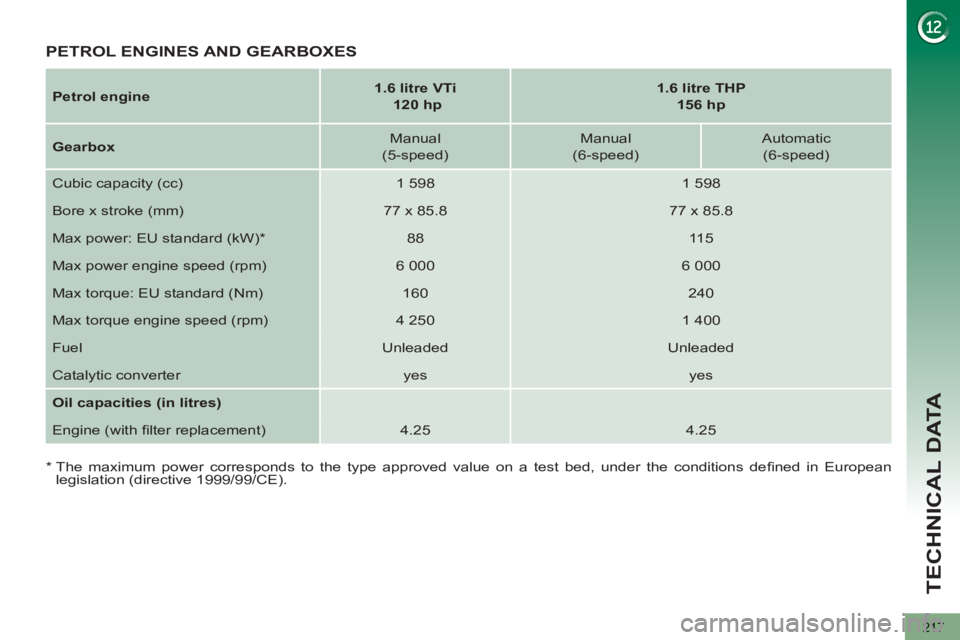
TECHNICAL DATA
217
Petrol engine
1.6 litre VTi
120 hp
1.6 litre THP
156 hp
Gearbox
Manual
(5-speed)
Manual
(6-speed)
Automatic
(6-speed)
Cubic capacity (cc)
1 598
1 598
Bore x stroke (mm)
77 x 85.8
77 x 85.8
Max power: EU standard (kW) *
88
11 5
Max power engine speed (rpm)
6 000
6 000
Max torque: EU standard (Nm)
160
240
Max torque engine speed (rpm)
4 250
1 400
Fuel
Unleaded
Unleaded
Catalytic converter
yes
yes
Oil capacities (in litres)
Engine (with fi lter replacement)
4.25
4.25
PETROL ENGINES AND GEARBOXES
*
The maximum power corresponds to the type approved value on a test bed, under the conditions defi ned in European
legislation (directive 1999/99/CE).
Page 220 of 364
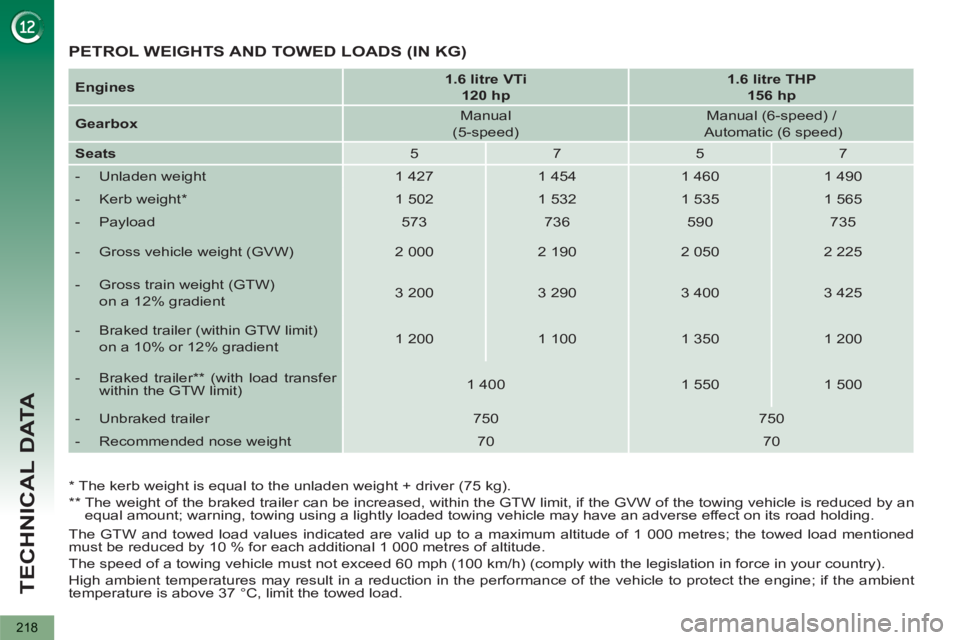
TECHNICAL DATA
218
The GTW and towed load values indicated are valid up to a maximum altitude of 1 000 metres; the towed load mentioned
must be reduced by 10 % for each additional 1 000 metres of altitude.
The speed of a towing vehicle must not exceed 60 mph (100 km/h) (comply with the legislation in force in your country).
High ambient temperatures may result in a reduction in the performance of the vehicle to protect the engine; if the ambient
temperature is above 37 °C, limit the towed load.
Engines
1.6 litre VTi
120 hp
1.6 litre THP
156 hp
Gearbox
Manual
(5-speed)
Manual (6-speed) /
Automatic (6 speed)
Seats
5
7
5
7
- Unladen weight
1 427
1 454
1 460
1 490
- Kerb weight *
1 502
1 532
1 535
1 565
- Payload
573
736
590
735
- Gross vehicle weight (GVW)
2 000
2 190
2 050
2 225
- Gross train weight (GTW)
on a 12% gradient
3 200
3 290
3 400
3 425
- Braked trailer (within GTW limit)
on a 10% or 12% gradient
1 200
1 100
1 350
1 200
- Braked trailer ** (with load transfer
within the GTW limit)
1 400
1 550
1 500
- Unbraked trailer
750
750
- Recommended nose weight
70
70
*
The kerb weight is equal to the unladen weight + driver (75 kg).
**
The weight of the braked trailer can be increased, within the GTW limit, if the GVW of the towing vehicle is reduced by an
equal amount; warning, towing using a lightly loaded towing vehicle may have an adverse effect on its road holding.
PETROL WEIGHTS AND TOWED LOADS (IN KG)